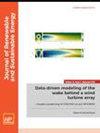利用 SARIMAX 对基于卫星和再分析的太阳辐照度数据进行准确性评估,以预测太阳能光伏发电量
IF 1.9
4区 工程技术
Q4 ENERGY & FUELS
引用次数: 0
摘要
预测模型往往受到数据可用性的限制,在预测太阳能光伏(PV)输出时,文献表明太阳辐照度对太阳能光伏输出的贡献最大。本研究的目的是在卫星太阳辐照度数据和再分析太阳辐照度数据(即短波辐射(SWR)和向下地表太阳辐射(SSRD))不可用的情况下,确定哪一种数据能更好地替代实地太阳辐照度数据来预测太阳能光伏发电量。本研究提出了九个带有外生变量的季节性自回归综合移动平均(SARIMAX)模型,以评估每个太阳辐照度数据与天气参数的预测性能。在仅使用历史数据预测太阳能光伏发电量的情况下,运行了三个季节自回归集成移动平均(SARIMA)模型来预测太阳能光伏发电量,并比较和验证了 SARIMAX 模型的有效性。根据菲律宾大气、地球物理和天文服务管理局的定义,分析按季节进行:干热、多雨和干冷。结果表明,在预测炎热干燥季节和凉爽干燥季节的太阳能光伏输出时,使用 SSRD 比 SWR 更好。在干热季,SSRD 的均方根误差值为 0.411 kW,而 SWR 为 0.416 kW。在凉爽的旱季,SSRD 的均方根误差值为 0.457 kW,而 SWR 为 0.471 kW。同时,在预测雨季的太阳能光伏输出时,SWR 的 RMSE 值分别为 0.375 千瓦和 0.401 千瓦,优于 SSRD。本文章由计算机程序翻译,如有差异,请以英文原文为准。
Accuracy assessment of satellite-based and reanalysis solar irradiance data for solar PV output forecasting using SARIMAX
Forecasting models are often constrained by data availability, and in forecasting solar photovoltaic (PV) output, the literature suggests that solar irradiance contributes the most to solar PV output. The objective of this study is to identify which between the satellite-based and reanalysis solar irradiance data, namely, short wave radiation (SWR) and surface solar radiation downward (SSRD), respectively, is a better alternative to in situ solar irradiance in forecasting solar PV output should the latter become unavailable. Nine seasonal autoregressive integrated moving average with exogenous variables (SARIMAX) models were presented in this study to assess the forecasting performance of each solar irradiance data together with weather parameters. Using only historical data to forecast solar PV output, three seasonal autoregressive integrated moving average (SARIMA) models were run to forecast solar PV output and to compare and validate the efficacy of the SARIMAX models. The analysis was divided into seasons as defined by the Philippine Atmospheric, Geophysical and Astronomical Services Administration: hot dry, rainy, and cool dry. Results show that the use of SSRD is a better alternative than SWR when forecasting solar PV output for the hot dry season and cool dry season. For the hot dry season, SSRD has an root mean square error (RMSE) value of 0.411 kW while SWR has 0.416 kW. For the cool dry season, SSRD has an RMSE value of 0.457 kW while SWR has 0.471 kW. Meanwhile, SWR outperforms SSRD when forecasting solar PV output during the rainy season, with RMSE values at 0.375 and 0.401 kW, respectively.
求助全文
通过发布文献求助,成功后即可免费获取论文全文。
去求助
来源期刊

Journal of Renewable and Sustainable Energy
ENERGY & FUELS-ENERGY & FUELS
CiteScore
4.30
自引率
12.00%
发文量
122
审稿时长
4.2 months
期刊介绍:
The Journal of Renewable and Sustainable Energy (JRSE) is an interdisciplinary, peer-reviewed journal covering all areas of renewable and sustainable energy relevant to the physical science and engineering communities. The interdisciplinary approach of the publication ensures that the editors draw from researchers worldwide in a diverse range of fields.
Topics covered include:
Renewable energy economics and policy
Renewable energy resource assessment
Solar energy: photovoltaics, solar thermal energy, solar energy for fuels
Wind energy: wind farms, rotors and blades, on- and offshore wind conditions, aerodynamics, fluid dynamics
Bioenergy: biofuels, biomass conversion, artificial photosynthesis
Distributed energy generation: rooftop PV, distributed fuel cells, distributed wind, micro-hydrogen power generation
Power distribution & systems modeling: power electronics and controls, smart grid
Energy efficient buildings: smart windows, PV, wind, power management
Energy conversion: flexoelectric, piezoelectric, thermoelectric, other technologies
Energy storage: batteries, supercapacitors, hydrogen storage, other fuels
Fuel cells: proton exchange membrane cells, solid oxide cells, hybrid fuel cells, other
Marine and hydroelectric energy: dams, tides, waves, other
Transportation: alternative vehicle technologies, plug-in technologies, other
Geothermal energy
 求助内容:
求助内容: 应助结果提醒方式:
应助结果提醒方式:


